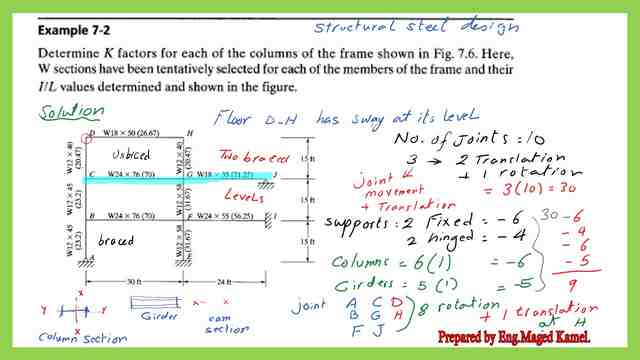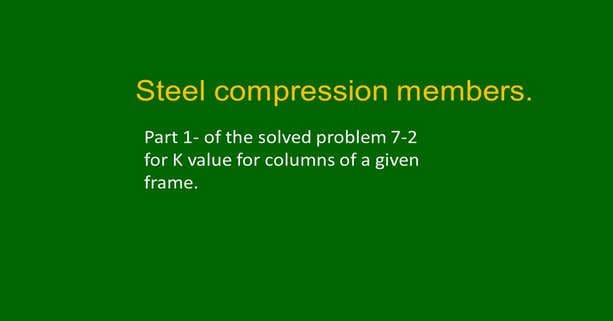Last Updated on March 21, 2024 by Maged kamel
Solved problem 7-2 for k value for frame 1/3.
Full description of the content.
We will start to discuss how to determine the k factors for each of the columns of the frame shown in Fig 7-6 for the solved problem 7-2 for the K value for the frame. Here are W sections that have been tentatively selected for each of the members of the frame and their I/L values determined and shown in the figure.
The girder’s data are shown for the upper girder W18x50.
The second girder is W24x76 but between brackets, has calculated the inertia Ix value and then divide the inertia by the length for each member, whether columns or girders to save time instead of logging to the tables,
Search for the inertia, for each member and then divide by the length of two floors we have bracings.
We have two floors that were braced the movement was restrained for joints B, C, F, G, I, J, the unbraced part is on and ly on the upper floor, we want to check.
Estimate rotations and translation of joints for the frame.
Let us determine the number of translations and rotations for all the joints, for the solved problem 7-2 for K value for frame 1/2. What matters is the translation between two joints to use the table for the k value for sway between one joint and the other joint, let us evaluate the number of joints, we have 10 joints.
Every joint, for this frame member, has two translations and one rotation. namely horizontal and vertical movements and one rotational. How much support do we have?
We have two fixed supports and two hinged supports.
For the fixed support, it takes restraint to both horizontal and vertical translation and one rotation.
So we deduct(2*3)=6, as for the hinges vertical and horizontal movements are prevented and one rotation is allowed, so we have (2*2)= 4 to be deducted.
For each member one translation is taken by the member so we have, we have 5 girders, so 5 horizontal translations were deducted
We have 6 columns, so 6 vertical translations were deducted. In the end, we have 10 joints*3=30 total translations and rotations. Let us consider each joint one by one. At E we have three total, two translations, and one rotation, taken by the fixed support at E.

At A, we have three total, two translations and one rotation, 2 taken by the hinged support at A.
We are left with one rotation, let us inspect point B. We have three total, two translations, and one rotation, 2 translations were taken by the two members at B, and we left with one rotation.
Let us check, joint F, we have three total, two translations, and one rotation, taken by the two members at F, we are left with one rotation, we cannot use member FB since it is used with joint B.

We have joint I, and all translations and rotations are taken by the fixed joint. we have joint C, and we have three total, two translations and one rotation, 2 translations taken by the two members, so we have one rotation, same at joint G, we have three total, two translations and one rotation, 2 translations taken by the two members, so we have one rotation.
At joint J, we have three total, two translations and one rotation, 2 translations taken by the hinge, and one rotation is left.
Let us proceed to joint D, we have three total, two translations, and one rotation, 2 translations taken by the two members DC and DH, and one rotation is left.
Let us proceed to joint H, we have three total, two translations, and one rotation, one translation is taken by member HG. Member Gh is already used by joint D, So we have sway and rotation at joint H.
Let us count, the number of rotations as follows for joints A, B, C, F, G, D, J, and H, we have 9 in total in which there are 8 rotations and one translation at H.

We have an unbraced frame for two columns. For All other remaining columns, there are no translations for B, C, F, G, J. The calculations are shown in the previous slide image.
We will continue our discussion for the solved problem 7-2 for the K value for the frame in the next post.
This is the pdf file used in the illustration of this post and the next post.
A very useful external link is Chapter 7 – Concentrically Loaded Compression, Members.
This is the next post Solved problems 7-2 for frames part 2.

